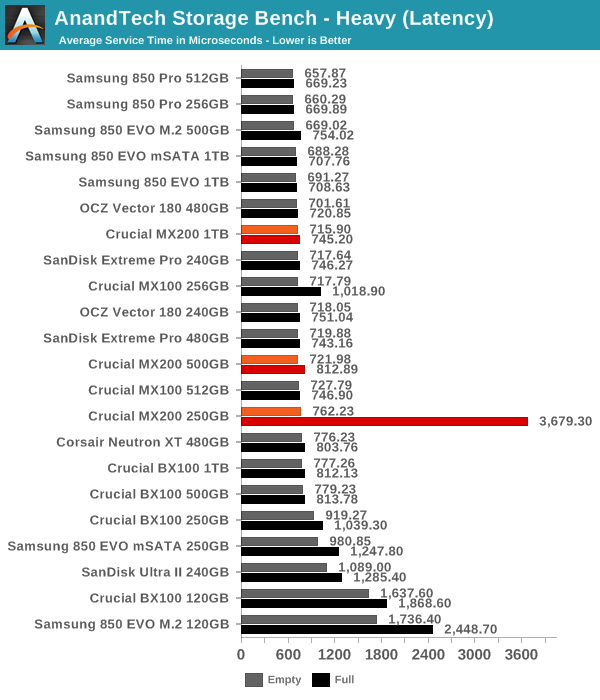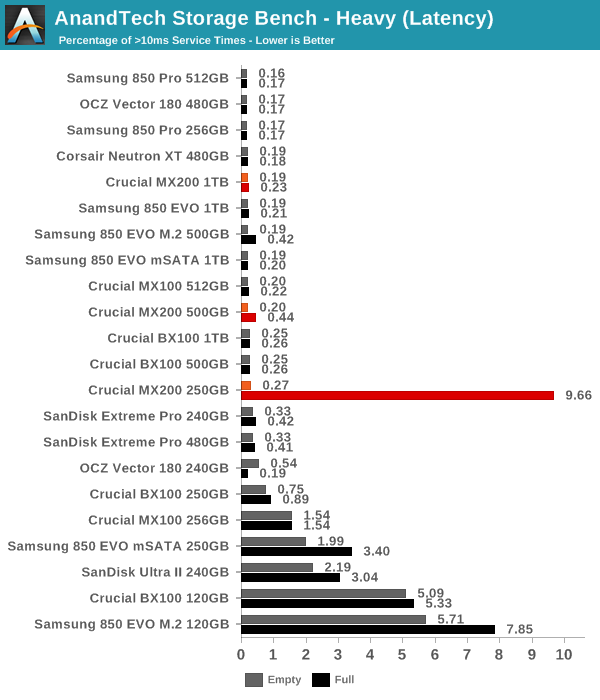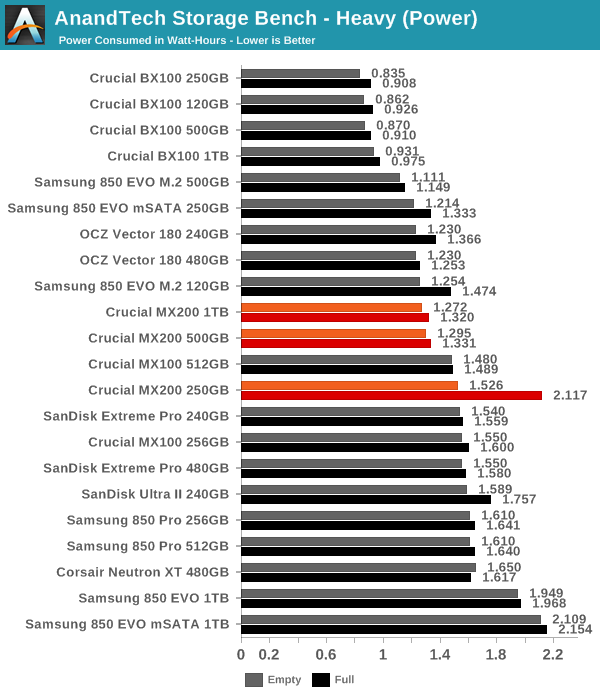Crucial MX200 (250GB, 500GB & 1TB) SSD Review
by Kristian Vättö on May 22, 2015 8:00 AM EST- Posted in
- Storage
- SSDs
- Crucial
- MX200
- Micron 16nm
AnandTech Storage Bench - Heavy
While The Destroyer focuses on sustained and worst-case performance by hammering the drive with nearly 1TB worth of writes, the Heavy trace provides a more typical enthusiast and power user workload. By writing less to the drive, the Heavy trace doesn't drive the SSD into steady-state and thus the trace gives us a good idea of peak performance combined with some basic garbage collection routines. For full details of the test, please refer to the this article.

In our Heavy trace the MX200 is an average drive: it's not as fast as Samsung drives, but roughly on par with the BX100. The most notable data point is the 250GB MX200 in full state because the drop in performance is tremendous, which is due to Dynamic Write Acceleration that is only enabled on the 250GB model. Because DWA writes everything to the SLC cache first, the drive constantly needs to migrate data from SLC to MLC, adding a significant amount of overhead and reducing the performance of host IOs.

The latencies are also good, except for the full 250GB MX200.

Power consumption under load is decent, but not BX100 level. The advantage over Samsung drives is notable, though, so the MX200 appears to be a pretty good fit for a laptop.











62 Comments
View All Comments
jonovw - Saturday, May 23, 2015 - link
When I got mine, the MX200 was pretty reasonably priced compared to it's competition for a M.2 SATA drive.MrMilli - Saturday, May 23, 2015 - link
"Another thing I'm not very satisfied with is the Dynamic Write Acceleration. I don't think an SLC cache is very useful in an MLC based drive because the performance benefits are marginal, at least with SATA 6Gbps."Sandisk showed with the Ultra II that SLC caching doesn't have to mean terrible latency if implemented correctly.
As a cheap drive, the ARC 100 is looking better every day. For typical desktop workloads, it 'feels' the fastest thanks to it's low latency. I don't understand why it's not recommended more often.
MrSpadge - Saturday, May 23, 2015 - link
I looks like Crucial should really tune their algorithm. Very short bursty writes, which still fit into the DRAM cache, can easily be written in MLC mode. There's enough time for time. Longer bursts could / should be written as SLC, if enough drive space is available. Otherwise MLC mode would be better, if it's likely the data would have to be reorganized soon anyway. Which also happens under long sustained writes, where there's a point where the drive should switch from SLC to MLC mode.Johnny Five - Saturday, May 23, 2015 - link
Well, going back to when SSD's were becoming all the rage and OCZ was having all their problems with their controllers, etc.... Crucial was one of the most consistently reliable and dependable SSD's in the market....... I have consistently used my 4 m4 series 128 GB SSD's for nearly 5 years without not 1 single problem, and have used (2) m550's or several years with no problems........reliability is what makes me keep returning to a certain vendor,, be it motherboard, memory, videocard, HDD, etc....so far my MX200 250 GB SSD is working just as great as my old C300 or m4's are doing.... lets hope that this MX200 lasts at least 3 to 4 years with no problems.... something I can not say for SSD's made by OCZ, Intel, Samsung, or HD's like Western digital, Seagate, Toshiba, Maxtor.......... ( am hoping that Western Digital HD's get better now that they bought out Hitachi........ I have over 18 hitachi Hard Drives ranging from 14 yrs old to 2 yrs old, and have yet to have one brick on me, like most every other brand has...... )
regarding TRIM and SSD degrading performance.......... after 5 years +/- continuous use of my Crucial m4 series SSD's ...... running test via AIDA64 Extreme Edition software, I am still running around 98.7 + % performance level, hopefully this MX200 will run just as good....
Impulses - Wednesday, May 27, 2015 - link
Crucial's had it's rash of firmware issues like anybody else...fokka - Saturday, May 23, 2015 - link
i didn't expect the bx100 to stay that competitive, i guess it's the drive to get right now, especially in a mobile setup where power draw matters.Harry Lloyd - Saturday, May 23, 2015 - link
I want a 512 GB drive with MX100/200 performance for about 100 $. Possible next year (3D NAND or something)?Ramon Zarat - Saturday, May 23, 2015 - link
I'm glad my 2 X Crucial M4 128GB in RAID0 are *STILL* king in 99.999% of my desktop scenarios. over 3 1/2 years now, and not as single issue. Still pumping ~900MB/s in sequential read, even at 75% full! Diskinfo reports them at 97% good. At this rate, they will last me well over 50 years before reaching 50% degradation!hrrmph - Saturday, May 23, 2015 - link
It's good to see AT posting critical reviews (where deserved) again.It's also good to see innovative thinking again, such as the call for the industry to benchmark SSDs at lower queue depths. I would like to read more on the low queue depth issues and which client machines / users are able to push above 1 or 2 QD (if any) and under what circumstances.
philipma1957 - Sunday, May 24, 2015 - link
It would be nice if either crucial or samsung would make larger ssd's in a 2.5 inch form factor.a 1.5tb or 2tb ssd gives me an all ssd system while a 1tb ssd gives me the need for a second drive.
Instead of the little tweaks here and there. Like this one (MX200) which seems to me a fail gives us the size increase. How many years since the first 1tb ssd from crucial (listed 960gb)